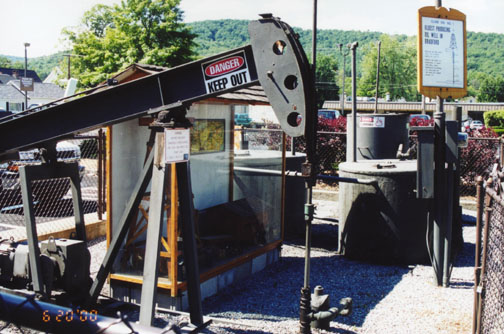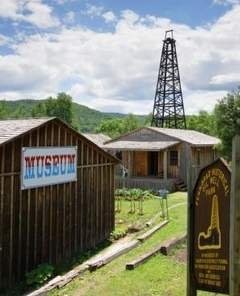
EARTHCACHE REQUIREMENTS
Each cacher must send his/her own answers BEFORE logging a find. ... "Geocachers must complete the tasks before they log the EarthCache as found." (4.3. EarthCache logging tasks)
Enjoy the journey (learning adventure) as well as the destination (smiley earned). Remember to take only pictures and leave only footprints. To get credit for this Earthcache, complete the following tasks:
NOTE: Answers via message -and- two pictures (log signatures) are required to post a find for this cache. 1. Pic at or near the coordinates / 2. Pic of oil derrick at waypoint
There are shale outcroppings visible throughout the area. These outcroppings are the type of rock that is infused with Pennsylvania Grade Crude Oil. The oil wells are tapping this natural resource.
1. MESSAGE …. Is the well pumping during your visit? If the well is pumping during your visit, note the polish rod. It is shiny. This indicates a working oil well. If the oil well was not working, the polish rod would be dull and tarnished.
2. MESSAGE …. This well produces oil from a _ _ foot body of Bradford _ _ _ _ _ _ _ .
3. MESSAGE …. Is this well getting oil above or below sea level? Explain. (NOTE: Use the information on the sign and your GPS to answer this question.)
4. MESSAGE …. Drilling for oil usually involved constructing a derrick and then shooting the well. This method has generally been replaced by fracking a well and rotary drilling. Explain the major differences between these two methods.
5. MESSAGE …. Why is Penn Grade Crude Oil considered a top quality oil?
6. MESSAGE …. . ... VISIT PENN BRAD OIL MUSEUM open April 1st to Nov 1st. ... Explore the various exhibits within the museum to answer the questions. Answers can also be found doing an internet search.
A. What was the only oil gusher ever encountered in the Bradford oil field? (2 words)
B. Who produced the first 2000 mile motor oil?
C. Who is someone who drills an exploration oil well in a new area?
D. Visit the case illustrating different rigs. How many rigs are depicted in the photos?
E. What is dropped in an oil well to detonate nitroglycerin? (2 words)
F. What is the name of the pump used to draw oil out of the ground?
G. What is used to find the contents at the bottom of an oil tank? (2 words)
H. What was the name of the lantern used so oilmen could work at night? (2 words)
I. Where was the engine made that powered the rig?
7. LOG …. Post a picture of you or your signature item at or near the coordinates. Post a picture with the derrick in the background. These pictures are your log signature. No spoiler pics.
OPTIONAL - Please respect the time and effort involved in finding and creating this earthcache by adding A and B to your log.
A. JOURNEY OF THE MIND ... Science explains what we observe. Relate (in your own words) something you found interesting in the reading. This adds to your learning adventure and your log.
B. JOURNEY OF THE HEART ... Art shares our personal experience of what we see. Share something special you found on site, and why it is special to you ... prose / story / poem / picture. This is a memorable addition to your log and will make other hearts smile.
Journeys of Heart and Mind ...
Stories to Touch the Heart and Puzzles to Challenge the Mind / Rainbow Tree Story


McKean is the principal oil-producing county of Pennsylvania with most of its production coming from the world famous Bradford Field in the north central part of the county. Natural gas is the principal product in the southern part of the county.
Pennsylvania Grade Crude Oil is a type of sweet crude oil. It is found primarily in the Appalachian basin in the states of New York, Pennsylvania, Ohio, and West Virginia, and takes its name for the state of Pennsylvania, where it was first extracted. Pennsylvania grade crude oil can be broken down into gasoline, kerosene, fuel oil, gas oil, wax distillate, cylinder stock (or bottoms) and other refined products such as white oil and paraffin.
Pennsylvania grade crude oil is thermally stable and has a high viscosity index. It is generally free of asphalt and has only trace amounts of sulfur and nitrogen. It is also high in paraffin and other waxes making it highly desirable for refinement into petroleum lubricants such as motor oil. Its products are also valuable for use in certain hydraulic applications. By-products are commonly found in consumer goods such as cosmetics, and topical ointments.
Products refined from this type of oil are particularly prized as lubricants and many oil companies prominently display the fact that they use Pennsylvania Grade crude oil in their products.
Bradford, Pennsylvania is the major center for the refining of Pennsylvania grade crude oil. The posted coordinates will take you to McDonald's Parking Lot, the site of a working oil well - CLINE OIL NO. 1.
HISTORY OF CLINE OIL NO. 1
Information provided by Joyce Cline. THANK YOU.
Cline Oil No.1 was drilled in the late 1870’s by Thomas Bradley. All early records of the well’s drilling and completion have been lost or destroyed. However, more than likely it was drilled with a standard rig that was built on the spot and was prepared for production by “shooting” the well with nitroglycerine.
Records do show the oil rights being passed from Bradley to W.E. Detlor and Charles Spreter in 1889, to J.A. Fitzgibbon (date unknown), to A.W. Klingler in 1936, to Milo G Cline in 1938, and, in 1946, to the current owner, Willard M Cline, who has actually pumped and maintained the well since 1937.
The well would have originally been operated by the rig that drilled it, powered by a steam engine. The rig was replaced with a gas engine and gear power, run by natural gas from the well. An electric motor replaced the gas engine, and both were eventually upgraded to an electric pumping jack unit, which powers the well today.
In 1946 the well was “land-locked” by the General Garage and showroom, Still’s Funeral Home and garage, the Boylston Street Garage, and the Holley Hotel. Access to the well for servicing and maintenance was through an alley off of Main Street, between the General Garage showroom and a cigar shop.
The “General Garage Well”, as it was referred to for many years, can be seen in all early drawings and maps of downtown Bradford. It was the only oil well known to have been drilled on the block bounded by Main, Davis, Boylston, and Kennedy Streets.
By the early 1970’s, the adjoining buildings had all succumbed to “urban renewal” and the land became a city parking lot. During this period, the Clines blocked several attempts by the city to condemn the well and force it to be plugged. McDonald’s then expressed interest in incorporating the well into its plan to build on the site. It thus became the first and only McDonald’s Restaurant known to have a working oil well within its drive-thru.
Today, after producing for over one hundred and thirty years, the well can still yield a barrel (42 gallons) of Pennsylvania Grade Crude Oil per day from the Bradford 3rd sand. At one point in its history, it also supplied natural gas to heat the Still Funeral Home garage. Cline Oil No.1—the “McDonald’s Well”—is one of the most popular tourist attractions in downtown Bradford and probably the most visited and photographed well north of Titusville’s historic Drake Well.
RESOURCES ... Topographic and Geologic Survey - George H. Ashley, State Geologist - Bulletin 111 - May 1934 http://bridgehunter.com/maps/detail/pa/mckean/county-big-map.png http://www.soest.hawaii.edu/GG/FACULTY/POPP/Sept30_Ch_10.pdf
Derrick vs Rotary??? Ok, as far as I know, the drilling structure used in modern rotary drilling is still called a "derrick", but is a temporary structure (steel) that is moved to the next well. The old derricks were wood, and usually abandoned after drilling. In the days of Cline #1, drilling was percussive, as in pile driving. The rotary drill put a rotating bit on the end of the drill string to grind away at the hardest rock layers, and permitted deeper drilling. Shooting a well was detonating a charge of explosive at the base of the well to fracture the rock and allow oil to flow into the well. But the fractures in the rock could close, and reduce the flow of oil. With hydro-fracking, the rock layers are broken open by high pressure fluids, including nasty, poison chemicals that can contaminate the drinking water. After fracking, a sand slurry is pumped into the rock to hold the fractures open, and keep oil/gas flowing into the well. (From Internet)